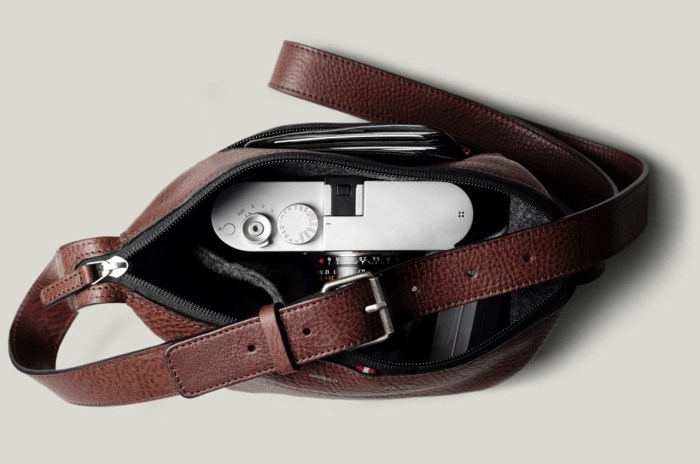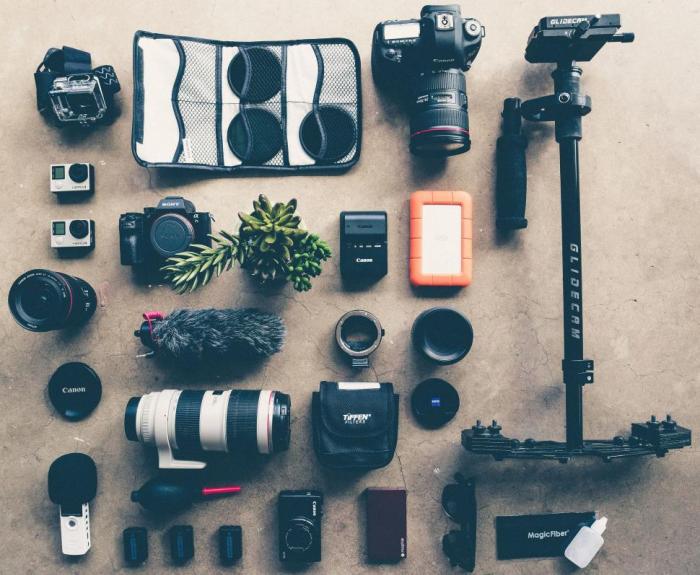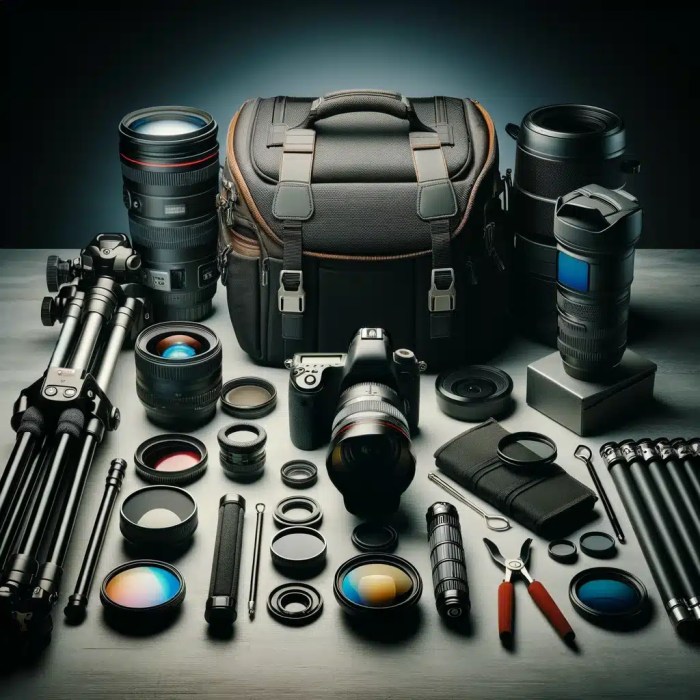Best Camera Lenses for Photography Enthusiasts
Best accessories for photography lovers – Choosing the right camera lens is crucial for achieving your photographic vision. Understanding the differences between prime and zoom lenses, along with factors like aperture, focal length, and image stabilization, will significantly impact your image quality and creative possibilities. This section will guide you through the essential considerations for selecting the perfect lens for your needs.
Prime vs. Zoom Lenses: A Comparison
Prime lenses offer a fixed focal length, while zoom lenses allow you to adjust the focal length. Prime lenses generally produce sharper images with wider maximum apertures, leading to better low-light performance and shallower depth of field. However, their fixed focal length limits flexibility. Zoom lenses offer versatility but may compromise image sharpness and aperture at certain focal lengths. The best choice depends on your photography style and subject matter.
Popular Camera Lenses: A Comparison Table
| Lens | Focal Length | Maximum Aperture | Image Stabilization |
|---|---|---|---|
| Canon EF 50mm f/1.8 STM | 50mm | f/1.8 | No |
| Nikon AF-S DX NIKKOR 35mm f/1.8G | 35mm | f/1.8 | No |
| Sony FE 24-70mm f/2.8 GM | 24-70mm | f/2.8 | Yes |
| Tamron 150-600mm f/5-6.3 Di III VC VXD | 150-600mm | f/5-6.3 | Yes |
| Sigma 85mm f/1.4 DG DN Art | 85mm | f/1.4 | No |
The Importance of Aperture, Focal Length, and Image Stabilization
Aperture controls the amount of light entering the lens, influencing depth of field. A wider aperture (smaller f-number) creates a shallow depth of field, ideal for portraits with blurred backgrounds. Focal length determines the field of view and magnification. A longer focal length compresses perspective and magnifies distant subjects, suitable for wildlife photography. Image stabilization compensates for camera shake, resulting in sharper images, particularly beneficial in low-light conditions or when using longer lenses.
Essential Camera Accessories: Beyond the Lens
While a great lens is essential, several other accessories significantly enhance your photography experience and image quality. These additions boost your creative control and overall workflow.
Five Must-Have Accessories for Beginner Photographers
- Extra Battery: Prevents missed shots due to power depletion.
- Memory Cards: Ample storage capacity to capture numerous photos and videos.
- Camera Bag: Secure and organized transport for your equipment.
- Cleaning Kit: Maintains lens and sensor cleanliness for optimal image quality.
- Remote Shutter Release: Minimizes camera shake for sharper images, especially during long exposures.
Accessories that Improve Image Quality
- UV Filter: Protects the lens from scratches and dust.
- Polarizing Filter: Reduces glare and enhances color saturation.
- Neutral Density (ND) Filter: Allows for slower shutter speeds in bright conditions, useful for creative effects like motion blur.
- Graduated Neutral Density (GND) Filter: Balances exposure in scenes with significant brightness differences, like landscapes with bright skies.
The Benefits of Using a Tripod
A tripod provides stability, crucial for sharp images, especially in low light or when using longer shutter speeds. It enables long-exposure photography, allowing for creative effects like light trails and silky smooth water.
Lighting Equipment for Photography Lovers
Mastering lighting is key to captivating photography. Understanding the nuances of natural and artificial light sources, and choosing the right equipment, empowers you to shape the mood and atmosphere of your images.
Natural Light vs. Artificial Lighting
Natural light offers a soft, diffused quality, often ideal for portraits and landscapes. However, it’s unpredictable and changes constantly. Artificial lighting provides precise control over light direction, intensity, and color temperature, allowing for consistent results and creative flexibility, but requires investment in equipment and expertise.
Choosing the Right Lighting Equipment
Budget and photography style dictate lighting equipment choices. Speedlights are portable and versatile, suitable for events and on-location shoots. Continuous lighting offers real-time preview and is ideal for studio work and video. Softboxes diffuse light, creating a softer, more flattering effect.
Different Lighting Setups and Their Effects
A single light source from the side can create dramatic shadows and highlight textures. Multiple lights can illuminate a subject evenly or create complex lighting patterns. Backlighting can create silhouettes and ethereal effects. The possibilities are endless, allowing photographers to tailor lighting to evoke specific moods and atmospheres.
Post-Processing Tools and Software
Post-processing software empowers you to enhance your images, correcting flaws and refining your artistic vision. Choosing the right software depends on your skill level, budget, and specific needs.
Essential Post-Processing Software Options
Adobe Lightroom is popular for its intuitive interface and powerful organization tools, ideal for both beginners and professionals. Adobe Photoshop offers advanced retouching and manipulation capabilities, suited for experienced users. Capture One is a professional-grade software known for its color accuracy and tethered shooting capabilities.
Basic Image Editing Techniques in Adobe Lightroom
Color correction involves adjusting white balance, exposure, contrast, and saturation to achieve accurate and pleasing colors. Sharpening enhances detail and clarity. Cropping improves composition and removes unwanted elements from the image.
Comparison of Photo Editing Software
| Software | Key Features | Target User | Pricing |
|---|---|---|---|
| Adobe Lightroom | Organization, basic editing, color grading | Beginners to professionals | Subscription |
| Adobe Photoshop | Advanced retouching, manipulation, compositing | Intermediate to professionals | Subscription |
| Capture One | Tethered shooting, color accuracy, advanced editing | Professionals | One-time purchase or subscription |
Bags and Carrying Cases for Photographers
Protecting your valuable camera gear is paramount. Choosing the right bag depends on your equipment, shooting style, and personal preferences. This section explores various bag types and crucial considerations for selecting the best fit.
Choosing the Right Camera Bag
Consider the size and weight of your equipment. Backpacks offer comfort for carrying heavy loads, while shoulder bags are more convenient for lighter setups. Slings provide quick access, ideal for street photography. Each style presents unique advantages and disadvantages regarding comfort, accessibility, and protection.
Types of Camera Bags: A Comparison
Backpacks provide excellent organization and weight distribution but can be cumbersome in tight spaces. Shoulder bags are more compact and offer easy access but may strain your shoulder with heavy loads. Sling bags combine the convenience of shoulder bags with improved weight distribution, providing a good balance between accessibility and comfort.
Important Considerations When Selecting a Camera Bag, Best accessories for photography lovers
Padding protects your equipment from impacts. Weather resistance safeguards your gear from the elements. Internal organization keeps everything neatly arranged and easily accessible. These factors contribute to the longevity and functionality of your camera bag.
Filters and Their Applications in Photography
Photographic filters modify light entering the lens, allowing for creative control and image enhancement. Understanding their functions and applications is key to elevating your photography.
Function and Use of Various Photographic Filters
Neutral Density (ND) filters reduce light transmission, enabling slower shutter speeds for motion blur effects or wider apertures in bright conditions. Polarizing filters reduce glare and enhance color saturation, particularly effective in landscape photography. Graduated Neutral Density (GND) filters darken a portion of the image, useful for balancing exposure in scenes with significant brightness differences.
Examples of Filter Enhancement in Different Shooting Situations
ND filters create silky smooth water in long-exposure landscape shots. Polarizing filters enhance the blue of the sky and reduce glare on water surfaces in landscapes and portraits. GND filters balance exposure between a bright sky and a darker foreground in landscapes.
The Effects of a Polarizing Filter on a Landscape Photo

A polarizing filter dramatically reduces glare on reflective surfaces like water and foliage, enhancing color saturation and revealing details often obscured by reflections. The sky becomes deeper blue, and colors appear more vibrant and intense, creating a more dynamic and visually appealing image. The effect is most noticeable when the sun is at a relatively high angle to the subject.
Remote Triggers and Other Accessories for Creative Control
Remote triggers and other accessories expand your creative possibilities, enabling techniques not easily achievable with standard camera operation. This section explores their benefits and applications.
Benefits of Using a Remote Shutter Release

Remote shutter releases minimize camera shake, resulting in sharper images, especially during long exposures or when shooting in low light. They are essential for time-lapse photography and allow for remote triggering of the camera, useful for wildlife photography or self-portraits.
Advantages of Using Intervalometers for Time-Lapse Photography
Intervalometers precisely control the shooting interval and the total number of shots in time-lapse photography. This ensures consistent image capture, creating seamless and captivating time-lapse sequences. They allow for the creation of stunning videos showcasing changes over time.
The Role of a Lens Hood in Protecting the Lens and Improving Image Quality

A lens hood shields the lens from unwanted light, preventing lens flare and improving contrast. It also protects the front element of the lens from impacts and scratches, extending the life of your valuable equipment.
Closing Summary: Best Accessories For Photography Lovers
Ultimately, the best photography accessories are those that empower you to express your creative vision. By carefully considering your needs and budget, and exploring the options presented in this guide, you can equip yourself with the tools to capture stunning photographs and fully realize your photographic aspirations. Remember that the journey of a photographer is a continuous process of learning and experimentation – so embrace the process and enjoy the creative possibilities!
